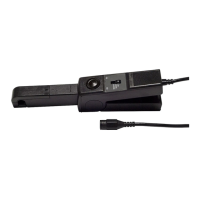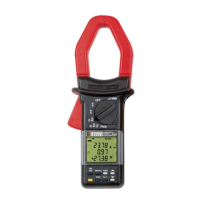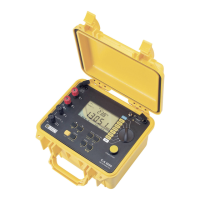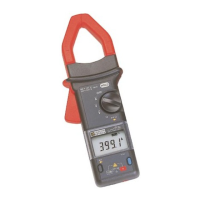8
3.9.2 Time between charges
This is at least 8 hours with back-lighting on and at
least 40 hours with the screen-saver activated
(display unit off) when the storage batteries supplied
with the instrument are used.
3.9.3 Recharging of the storage batteries
See also § 12.2, on page 39. The storage batteries
are recharged using the mains power unit supplied
with the instrument. It is connected to the C.A 8230
using the jack (Figure 3, item 1). Use only the mains
power unit supplied with the equipment.
With fully discharged storage batteries, the charging
time is approximately four hours. Once the battery is
recharged, the instrument uses mains power and
does not discharge the battery.
Note: when the mains power unit is connected, the
orange indicator (Figure 1, item 8) lights.
3.9.4 Changing the storage batteries
When you change the storage batteries, you must
disconnect the C.A 8230 from mains and from the
network being measured; the instrument is then no
longer supplied by any voltage source. The C.A
8230 preserves the timestamp settings for
approximately 1 minute.
3.9.5 Storage batteries
The C.A 8230 is powered by six rechargeable NiMH
storage batteries (Figure 4, item 1) in AA format
(LR6 - NEDA 15) having a capacity of at least 1800
mAh. At least 8 hours of self-contained operation
with the screen on is ensured. If the screen is off
(standby mode during an alarm or recording
campaign), at least 40 hours of self-contained
operation are ensured.
The storage batteries can be reached, from the
back of the C.A 8230, after turning the "quarter turn"
lock (Figure 4, item 2) anti-clockwise; use a coin
(Figure 4, item 3).
Note: with NiCd storage batteries (at least 900
mAh), recharging lasts approximately 1h30 and a
full charge allows self-contained operation for 4
hours (screen on) or 20 hours (screen off).
Figure 4: Access to storage batteries. 003
3.9.6 Operation on mains power
The presence of the storage batteries is not
essential for operation on mains power. However,
there is a risk of losing data if the mains power is
disconnected during recording, for example.
3.10 Prop
A retractable prop (Figure 4, item 4) on the back of
the C.A 8230 holds the instrument in position 30°
from the horizontal.
3.11 Summary of functions
3.11.1 Measurement functions
• RMS AC voltage up to 600 V.
• RMS AC current up to 6,500 A.
• DC voltage and current.
• RMS values on half-period, minimum and
maximum in voltage and current.
• Peak values of voltage and current.
• Frequency of 50Hz and 60Hz networks
(measurement range: 40Hz to 70Hz).
• Peak factor of current and voltage.
• K factor (KF) of current (for transformers).
• Distortion factor (DF) of current and voltage
(also called THD-R).
• Total harmonic distortion (THD) of current and
voltage (also called THD-F).
• Active, reactive (capacitive and inductive), and
apparent power.
• Power factor (PF) and displacement factor
(DPF or cos Φ).
• Total active, reactive (capacitive and inductive),
and apparent power in balanced three-phase
mode (3 Φ) with or without neutral.
• Determination of order of phase rotation (2-wire
method): display of phase order of a three-
phase network.
• Selection of current transformer ratio for the
MN93A clip (5A rating) and the 5A adapter.
• Automatic recognition of type of current sensor.
• Display of waveforms (voltage and current).
• Short-term flicker (PST).
• Active, reactive (capacitive and inductive), and
apparent energy (total in balanced three-phase
mode).
• Harmonics of current and voltage up to order
50: RMS value, percentage with respect to the
fundamental, minimum and maximum and (in
single-phase mode only) sequence of the
harmonics.
• Harmonics of the apparent power (in single-
phase mode only) up to order 50: value,
percentage with respect to the fundamental,
minimum and maximum.

